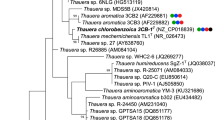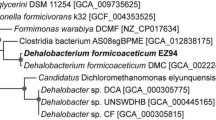Abstract
A bacterial strain able to degrade dichloromethane (DCM) as the sole carbon source was isolated from a wastewater treatment plant receiving domestic and pharmaceutical effluent. 16S rDNA studies revealed the strain to be a Xanthobacter sp. (strain TM1). The new isolated strain when grown aerobically on DCM showed Luong type growth kinetics, with μmax of 0.094 h−1 and S m of 1,435 mg l−1. Strain TM1 was able to degrade other aromatic and aliphatic halogenated compounds, such as halobenzoates, 2-chloroethanol and dichloroethane. The gene for DCM dehalogenase, which is the key enzyme in DCM degradation, was amplified through PCR reactions. Strain TM1 contains type A DCM dehalogenase (dcmAa), while no product could be obtained for type B dehalogense (dcmAb). The sequence was compared against 12 dcmAa from other DCM degrading strains and 98% or 99% similarity was observed with all other previously isolated DCM dehalogenase genes. This is the first time a Xanthobacter sp. is reported to degrade DCM.



Similar content being viewed by others
References
Ames R, Brown J, Wand Y (2000) Public health goals form dichloromethane in drinking water. Office of Environmental Health Hazard Assessment, California Environmental Protection Agency—Pesticide and Environmental Toxicology Section
Andrews JF (1968) A mathematical model for the continuous culture of microorganisms utilizing inhibitory substrates. Biotechnol Bioeng 10:707–723. doi:10.1002/bit.260100602
Bader R, Leisinger T (1994) Isolation and characterization of the Methylophilus sp. strain DM11 gene encoding dichloromethane dehalogenase/glutathione S-transferase. J Bacteriol 176:3466–3473
Carvalho MF, Alves CC, Ferreira MI, De Marco P, Castro PML (2002) Isolation and initial characterization of bacterial consortia able to mineralize fluorobenzene. Appl Environ Microbiol 68:102–105. doi:10.1128/AEM.68.1.102-105.2002
Carvalho MF, Ferreira Jorge R, Pacheco CC, De Marco P, Castro PM (2005) Isolation and properties of a pure bacterial strain capable of fluorobenzene degradation as sole carbon and energy source. Environ Microbiol 7:294–298
DeSantis TZ, Hugenholtz P, Keller K, Brodie EL, Larsen N, Piceno YM et al (2006) NAST: a multiple sequence alignment server for comparative analysis of 16S rRNA genes. Nucleic Acids Res 34:W394–W399. doi:10.1093/nar/gkl244
De Souza M, Seffernick J, Martinez B, Sadowsky MJ, Wackett LP (1998) The atrazine catabolism genes atzABC are widespread and highly conserved. J Bacteriol 180:1951–1954
Doronina NV, Braus-Stromeyer SA, Leisinger T, Trotsenko YA (1995) Isolation and characterization of a new facultative methylothrophic bacterium: description of Methylorhabdus multivorans gen. nov., sp. nov. Syst Appl Microbiol 18:92–98
Edwards VH (1970) The influence of high substrate concentration on microbial kinetics. Biotechnol Bioeng 12:679–712. doi:10.1002/bit.260120504
Evens GJ, Ferguson GP, Booth IR, Vuilleumier S (2000) Growth inhibition of Escherichia coli by dichloromethane dehalogense/glutathione S-transferase. Microbiology 146:2967–2975
Ferreira Jorge RM, Livingston AG (1999) Novel method for characterisation of microbial growth kinetics on volatile organic compounds. Appl Microbiol Biotechnol 52:174–178. doi:10.1007/s002530051505
Freitas dos Santos LM, Livingston AG (1993) A novel bioreactor system for the destruction of volatile organic compounds. Appl Microbiol Biotechnol 40:151–157. doi:10.1007/BF00170444
Gälli D, Leisinger T (1985) Specialized bacterial strains for the removal of dichloromethane from industrial waste. Conserv Recycl 8:91–100. doi:10.1016/0361-3658(85)90028-1
Gisi D, Willi L, Traber H, Leisinger T, Vuilleumier S (1998) Effects of bacterial host and dichloromethane dehalogenase on the competitiveness of methyltrophic bacteria growing with dichloromethane. Appl Environ Microbiol 64:1194–1202
Hirano S, Kitauchi F, Haruki M, Imanaka T, Morikawa M, Kanaya S (2004) Isolation and characterization of Xanthobacter polyaromaticivorans sp. no. 127W that degrades polycyclic and heterocyclic aromatic compounds under extremely low oxygen conditions. Biosci Biotechnol Biochem 68:557–564. doi:10.1271/bbb.68.557
Howard PH (1990) Handbook of environmental fate of exposure data for organic chemicals, vol 2. Lewis Publishers Inc, Chelsea, MI, pp 176–183
Iwasaki I, Utsumi S, Hagino K, Ozawa T (1956) A new spectrophotometric method for the determination of small amounts of chloride using the mercury thiocyanate method. J Chem Soc Jpn 29:860–864. doi:10.1246/bcsj.29.860
Janssen DB, Scheper A, Dijkenhizen L, Witholt B (1985) Degradation of halogenated aliphatic compounds by Xanthobacter autotrophicus GJ10. Appl Environ Microbiol 49:673–677
Janssen DB, van den Wijngaard AJ, van der Waarde JJ, Oldenhuis R (1991) Biochemistry and kinetics of aerobic degradation of chlorinated aliphatic hydrocarbons. In: Hinchee RE, Olfenbuttel RF (eds) On-site bioreclamation. Butterworth-Heinmann, Boston, pp 92–112
Janssen DB, Dinkla IJ, Poelarends GJ, Terpstra P (2005) Bacterial degradation of xenobiotic compounds: evolution and distribution of novel enzyme activities. Environ Microbiol 7:1868–1882. doi:10.1111/j.1462-2920.2005.00966.x
Kohler-Staub D, Leisinger T (1985) Dichloromethane dehalogenase of Hyphomicrobium sp. strain DM2. J Bacteriol 162:676–678
Krausova VI, Robb FT, González JM (2006) Biodegradation of dichloromethane in an estuarine environment. Hydrobiologia 559:77–83. doi:10.1007/s10750-004-0571-5
Lane DJ (1991) 16S/23S rRNA sequencing. In: Stackebrandt E, Goodfellow M (eds) Nucleic acid techniques in bacterial systematics. Wiley, Chichester, pp 115–175
La Roche SD, Leisinger T (1990) Sequence analysis and expression of the bacterial dichloromethane dehalogenase structural gene, a member of the glutathione S-transferase supergene family. J Bacteriol 172:164–171
Line DE, Wu J, Arnold JA, Jennings GD, Rubin AR (1997) Water quality of first flush runoff from 20 industrial sites. Water Environ Res 69:305–310. doi:10.2175/106143097X125489
Ludwig W, Strunk O, Westram R, Richter L, Meier H, Yadhukumar , Buchner A, Lai T, Steppi S, Jobb G, Förster W, Brettske I, Gerber S, Ginhart AW, Gross O, Grumann S, Hermann S, Jost R, König A, Liss T, Lüßmann R, May M, Nonhoff B, Reichel B, Strehlow R, Stamatakis AP, Stuckmann N, Vilbig A, Lenke M, Ludwig T, Bode A, Schleifer K-H (2004) ARB: a software environment for sequence data. Nucleic Acids Res 32:1363–1371. doi:10.1093/nar/gkh293
Luong JHT (1987) Generalization of Monod kinetics for analysis of growth data with substrate inhibition. Biotechnol Bioeng 29:242–248. doi:10.1002/bit.260290215
Mägli A, Wendt M, Leisinger T (1996) Isolation and characterization of Dehalobacterium formicoaceticum gen nov. sp. no., a strictly anaerobic bacterium utilizing dichloromethane as source of carbon and energy. Arch Microbiol 166:101–108. doi:10.1007/s002030050362
Monod J (1949) The growth of bacterial cultures. Annu Rev Microbiol 3:371–394. doi:10.1146/annurev.mi.03.100149.002103
Nikolausz M, Kappelmeyer U, Nijenhuis I, Ziller K, Kästner M (2005) Molecular characterization of dichloromethane-degrading Hyphomicrobium strain using rDNA and DCM dehalogenase gene sequences. Syst Appl Microbiol 28:582–587. doi:10.1016/j.syapm.2005.03.011
Ottengraf SPP, Meesters JJP, van den Oever AHC, Rozema HR (1986) Biological elimination of volatile xenobiotic compounds in biofilters. Bioprocess Eng 1:61–69. doi:10.1007/BF00387497
Padden AN, Rainey FA, Kelly DP, Wood AP (1997) Xanthobacter tagetidis sp. nov., an organism associated with Tagetes species and able to grow on substituted thiophenes. Int J Syst Bacteriol 47:394–401
Poelarends GJ, Kulakov LA, Larkin MJ, Vlieg JET, Jansson DB (2000) Roles of horizontal gene transfer and gene integration in evolution of 1,3-dichloropropene- and 1,2-dibromoethane-degradative pathways. J Bacteriol 182:2191–2199. doi:10.1128/JB.182.8.2191-2199.2000
Saitou N, Nei M (1987) The neighbor-joining method: a new method for reconstructing phylogenetic trees. Mol Biol Evol 4:406–425
Schmid-Appert M, Zoller K, Traber H, Vuilleumier S, Leisinger T (1997) Association of newly discovered IS elements with the dichloromethane utilization genes of methylotrophic bacteria. Microbiology 143:2557–2567
Scholtz R, Wackett LP, Egli C, Cook AM, Leisinger T (1988) Dichloromethane dehalogenase with improved catalytic activity isolated from a fast growing dichloromethane-utilizing bacterium. J Bacteriol 170:5698–5704
Song J-S, Lee D-H, Lee K, Kim CK (2004) Genetic organization of the dhlA gene encoding 1,2-dichloroethane dechlorinase from Xanthobacter flavus UE15. J Microbiol 42:188–193
Spiess E, Sommer C, Görisch H (1995) Degradation of 1,4-dichlorobenzene by Xanthobacter flavus 14p1. Appl Environ Microbiol 61:3884–3888
Stubner S, Wind T, Conrad R (1998) Sulfur oxidation in rice field soil: activity, enumeration, isolation and characterization of thiosulphate-oxidizing bacteria. Syst Appl Microbiol 21:569–578
Stucki G, Gälli R, Ebersold HR, Leisinger T (1981) Dehalogenation of dichloromethane by cell extracts of Hyphomicrobium DM2. Arch Microbiol 130:366–371. doi:10.1007/BF00414602
Torz M, Wietzes P, Beschkov V, Janssen DB (2007) Metabolism of mono-and dihalogenated C1 and C2 compounds by Xanthobacter autotrophicus growing on 1,2-dichloroethane. Biodegradation 18:145–157. doi:10.1007/s10532-006-9050-1
Trotsenko YA, Doronina NV (2003) The biology of methylobacteria capable of degrading halomethanes. Microbiology 72:121–131. doi:10.1023/A:1023218326407
van den Wijngaard AJ, van den Kamp KWHJ, van der Ploeg J, Pries F, Kazemier B, Janssen DB (1992) Degradation of 1,2-dichloroethane by Ancylobacter aquaticus and other facultative methylotrophs. Appl Environ Microbiol 58:976–983
Vuilleumier S, Leisinger T (1996) Protein engineering studies of dichloromethane dehalogenase/glutathione S-transferase from Methylophilus sp. strain DM11. Ser12 but not Tyr6 is required for enzyme activity. Eur J Biochem 239:410–417. doi:10.1111/j.1432-1033.1996.0410u.x
Vuilleumier S, Ivoš N, Dean M, Leisinger T (2001) Sequence variation in dichloromethane dehalogenase/glutathione S-transferases. Microbiology 147:611–619
Wayman M, Tseng MC (1976) Inhibition threshold substrate concentrations. Biotechnol Bioeng 18:383–387. doi:10.1002/bit.260180308
Woldringh CL (1973) Effects of toluene and phenethyl alcohol on the ultrastructure of Escherichia coli. J Bacteriol 114:1359–1361
Zhou N-Y, Jenkins A, Chan Kwo Chion CKN, Leak DJ (1999) The alkene monooxygenase from Xanthobacter strain Py2 is closely related to aromatic monooxygenases and catalyzes aromatic monohydroxylation of benzene, toluene, and phenol. Appl Environ Microbiol 65:1589–1595
Zuber L, Dunn IJ, Deshusses MA (1997) Comparative scale-up and cost estimation of a biological trickling filter and a three-phase airlift bioreactor for the removal of methylene chloride from polluted air. J Air Waste Manag Assoc 47:969–975
Acknowledgements
This work was supported in part by the European Community’s Human Potential Programme under contract HP-RTH-CT-2002-00213 (BIOSAP). R. Ferreira Jorge would like to thank financial support from Fundação para a Ciência e Tecnologia (SFRH/BPD/18716/2004).
Author information
Authors and Affiliations
Corresponding author
Rights and permissions
About this article
Cite this article
Emanuelsson, M.A.E., Osuna, M.B., Ferreira Jorge, R.M. et al. Isolation of a Xanthobacter sp. degrading dichloromethane and characterization of the gene involved in the degradation. Biodegradation 20, 235–244 (2009). https://doi.org/10.1007/s10532-008-9216-0
Received:
Accepted:
Published:
Issue Date:
DOI: https://doi.org/10.1007/s10532-008-9216-0




